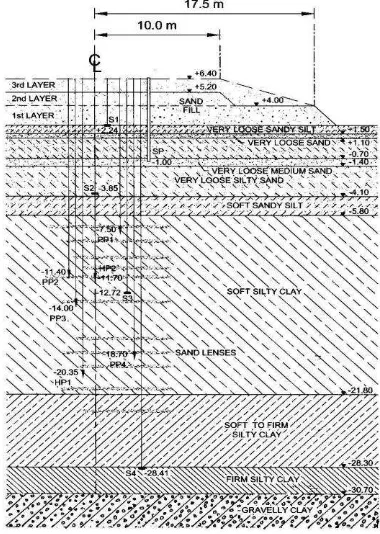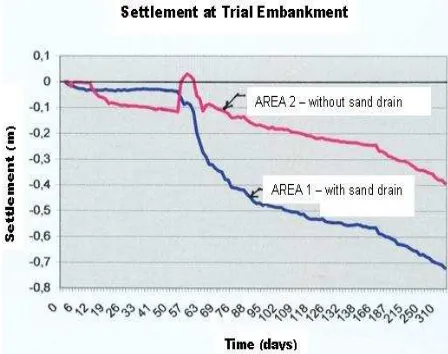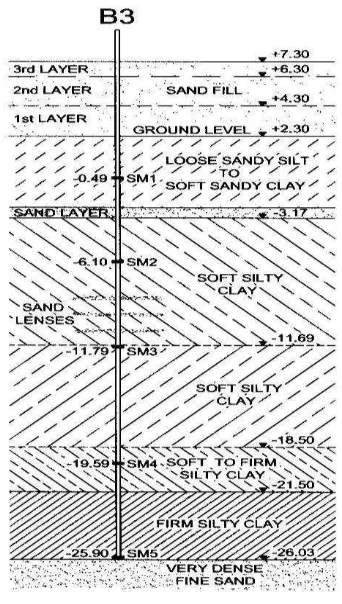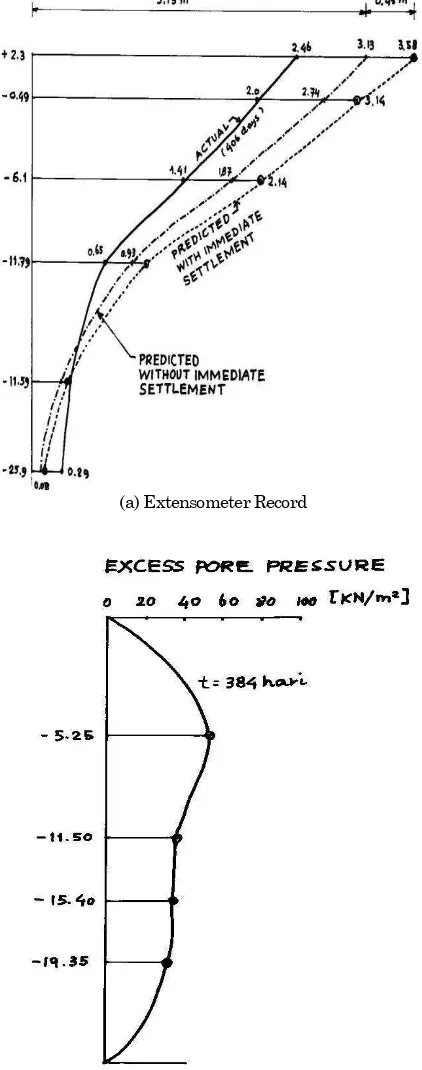Technical Note:
Application of Prefabricated Vertical Drain in Soil Improvement
Tedjakusuma, B.1
Note from the Editor: Although the use of Prefabricated Vertical Drain (PVD) in soil
improvement is not new, this paper is interesting since it gives the full spectrum from preliminary design stage; trial embankment and pilot test to final soil improvement. The final installation of the PVD was based on the soil investigation report and the results of instrumentation monitoring. Finally, using back analysis, vertical and horizontal coefficients of consolidation and compression index can be determined, which can be applied to predict a more accurate prediction of settlement.
Keywords: PVD, preloading, settlement, marine clay.
Introduction
Surabaya is a metropolitan city which is continuously expanding to its surrounding area, as a result of economic growth in Indonesia. The economic growth can be observed from increasing traffic flow of goods in the form of containers through Port of Surabaya, Tanjung Perak. The increase of container flows consequently requires large area as container yard. The development of this container yard is situated on western part of the harbor, formerly fish pond and sedimentary bay area. Soil type in this coastal area is very soft silty clay or marine clay layered with a thin layer of silt or fine sand.Soil layer from the surface up to 2 m depth consists of very loose silty sand, followed by 8 m thick of very soft silty clay layer. A 30-60 cm thick of sand layer was observed in this layer. In some places, sand lenses were found between 13 m and 15 m depth of soft silty clay layer. This layer is underlain by soft to firm clay layer. Sand layer with some gravel was found in 26-30 m depth.
In this project, ground improvement using Prefa-bricated Vertical Drains (PVD) with preloading was performed. Theoritically, the relationship between loading increment and settlement can be shown in Figure 1.
Initial settlement, ρi, occurred immediately after
loading p is applied, followed by consolidation ρ. Settlement ρc at the time t is given as:
1 Department of Civil Engineering, Faculty of Civil Engineering and Planning, Petra Christian University, Surabaya, INDONESIA. Email: [email protected]
Note: Discussion is expected before June, 1st 2012, and will be published in the “Civil Engineering Dimension” volume 14, number 2, September 2012.
Received 07 December 2011; revised 25 January 2012; accepted 04 February 2012.
ρc = U ρcf (1)
Where:
U = degree of consolidation
ρcf = final settlement.
Figure 2 shows the preloading process and its related settlement.
]
Figure 1. Relation between Loading and Settlement [1]
Figure 2. Relation between Preloading and Settlement [2]
reduced when settlement reaches the predicted settlement due to design loading time, tSR.
The installation of vertical drains will shorten the distance of drainage path, since water will flow horizontally to the vertical drain and upwards, which in turn will shorten the consolidation time. Therefore, two-dimentional consolidation theory is applied.
The relationship between degree of consolidation, U, horizontal,Uh, and vertical degree of consolidations,
Uv, can be obtained from Carillo equation [3]:
U= 1 – (1 – Uh) (1 – Uv) (2)
Vertical consolidation coefficient cv, can be obtained
from the consolidation test, while horizontal console-dation coefficient ch, is calculated using Barron
D = vertical draindistance d = vertical drain diameter t = consolidation time
Analysis of settlement is obtained using corrected result of consolidation test as proposed by Schmert-man [6] and the settlement effect during backfilling is analyzed using Schiffman method [7]. When settlement reaches design consolidation settlement, the surcharge load can be removed. Method pro-posed by Asaoka [8] was used to determine whether the backfill shall be added or removed.
Secondary compression settlement occurred when primary consolidation process was almost done, where excess pore pressureat that time was assumed to be zero.
tsec = time used for secondary compressionprocess
tp = time used for primary consolidation process
To study the effectiveness of vertical drains, a trial embankment using vertical sand drain was cons-tructed. Folowing the trial embankment, the addi-tional trial called Pilot Test using PVD was built to ensure the performance.
Trial Embankment
Trial embankment was built in the same area where the soil improvement would be conducted. The trial embankments was carried out to observe the settlement of embankment with and without vertical drains. In this trial embankment, sand drain, which is an early application of vertical drain to accelerate consolidation of soft, is used.
In the trial embankment area, 8–10 m thick of sandy silt or silty sand layers was found, then 10 m thick of soft clay layer having undrained shear strength of 0.165 kg/cm² contains thin soft sand layer, followed by 2–4 m thick of stiff clay with undrained shear strength of 0.5 kg/cm², and finally sand layer with gravel was found in 28.3 m deep
Pilot Test
Pilot test was constructed to ensure that soil impro-vement using PVD able to accelerate the consoli-dation process. Dimension of pilot test was 20x20 sqm with 3 m height of embankment.
PVD’s were driven every 1 m in rectangular pattern up to 30 m deep. To measure settlement develop-ment, settlement plates and extensometers were installed in various depths. To measure pore water pressure development, pneumatic piezometers and hydraulic piezometers were installed. Pneumatic Piezometer (PP), Settlement Plate (SP), Extenso-meter (S), and Hydraulic PiezoExtenso-meter (HP) installati-on can be seen in Figure 3.
Consolidation Analysis of Trial Embankment
Construction and planning for former fish pond area was conducted based on the result in Trial Embank-ment with maximum slope of 1:5. The settleEmbank-ment of Trial embankment is shown in Figure 4.
Figure 4. Settlement in Area 1 and Area 2
Settlement in Area 1 (using sand drains) is 3 times the settlement in Area 2 (without sand drains) in 90 days, 2 times in 280 days, and 1.85 times in 310 days.
Moeljadi and Setiawan [10], based on back calcula-tion, state that the vertical consolidation coefficient cv, and horizontal consolidation coefficient ch, are
about 0.0022 m2/day and 0.0069 m2/day, respectivelly.
While the secondary compression coefficient, cα, is 0.286.
Pilot Test
It was found that the observed settlement of embankment, obtained from settlement plate records as depicted in Figure 5.a, is in a good aggrement with settlement calculated using cv of
25.9 cm2/day, as shown in Figure 6.a. With average
cv of 25.9 cm²/day, the total settlement would take
approximately 85 years.
Degree of consolidation at 435 days observation of Pneumatic piezometer was about 79.7%. However, the record shows that pore pressure at the depth of 14 m significantly lower than those at the depth of 11m and 17m as shown in Figure 6.b. It is assumed that the piezometer experienced some error.
The amount by which the pressure in the pore water exceeds the stable ground water situation is termed the excess pore water pressure. The excess pore water pressure generation during load increment process in Pilot Test is presented in Figure 5.b.
(a) ExtensometerObservation Result
(b) Excess Pore Water Pressure
Figure 5. Extensometer and Excess Pore Water Pressure
observation in Pilot Test location
Container Yard
In general, the top layer in container yard consists of 5.5 m thick of very loose sandy silt to soft sandy clay, followed by 0.4 m thick of sand layer, and 15.2 m thick of soft clay layer. Below the 18.50 m depth, 8 meter thick of soft to firm silty clay and firm silty clay layer was found. Very dense fine sand is found at the depth of 26 meter.
The PVD with spacing of 1.5 x 1.5 sqm pattern were installed up to the depth of 26 m. To monitor the settlement of each layer, 5 Magnet Spiders (SM) were installed as sketched in Figure 7.
Based on consolidation tests of 11 undisturbed samples, the average cv is 25.7 cm²/day. For
(a) Extensometer Record
(b) Excess Pore Water Pressure Record
Figure 6. Monitoring Extensometer and Piezometer
Monitoring in Pilot Test Compared with Prediction
Settlement plate measurement for 406 days sank for 2.46 m. Based on each magnet spider and exten-someter, it were found that smaller settlement occurred with lower depth, as shown in Figure 9.a. Total settlement at 10 and 20 m deep from the surface was about 50% and 25%, respectively, com-pared to the settlement at the surface.
Degree of consolidation based on settlement plates monitoring was found 68.7%, while based on pneu-matic piezometers reading was 56.5%.
Figure 7. Soil Profile and instrumentation in B3
(a) Extensometer Observation Result
(b) Excess Pore Water Pressure Monitoring
Figure 8. Extensometer and Excess Pore Water Pressure
(a) Extensometer Record
(b) Excess Pore Water Pressure Record
Figure 9. Extensometer and Piezometer Monitoring in B3 Compared with Prediction
Evaluation
Asaoka method [8] is used to determine the time the surcharge load shall be removed. By plotting
settle-ment δi and settlement δ(i-1) on the 45 degree line, it
can be determined the time to remove the surcharge load, that is when the plot-settlement coincide with the 45 degree line, as shown in Figure 10.
δ i
(m
)
δ ( i -1 ) (m)
Figure 10. Evaluation using Asaoka Method in B3
Degree of consolidation about 70% and 90% were reached within 406 and 621 days, respectively.
Based on nomogram provided by Colbond [9], it was found that ch was 35.6 cm²/day, while the average cv
was 23.8 cm²/day. So, ch was about 1.5 times of cv.
This large value of ch might be caused by the
presense of several sand lenses. Using the afore-mentioned coeficient of consolidations, the calculated and observed settlement of embankment in contai-ner yard is presented in Figure 11.
Time (months)
S
e
tt
leme
nt
(m
)
Figure 11. Actual and Predicted Settlement Occurred in A5
Conclusions
Based on this study, it can be concluded that:
1. The ground improvement using Preloading and PVD on marine clay located on North of Sura-baya area is very effective. At 280 days, the rate of settlement of clay using PVD and preloading is twice as much as embankment without PVD. 2. Sand lenses between clay layers might affect the
rate of settlement.
m deep, decreased to 50%, and in 2 m deep, the settlement decreased about 25-20%.
4. Determination of the degree of consolidation based on settlement plates reading data is more reliable than the pneumatic piezometersreadings. 5. From the back analysis, it is concluded that hori-zontal and vertical consolidation coefficients for marine clay northern of Surabaya is 1.5.
6. Pneumatic piezometer instrument can be limited to each local soil type and it shall not be installed on sand lenses layer.
References
1. Rixner, J.J., Kraemer, S.R. and Smith, A.D.,
Prefabricated Vertical Drains, Vol. 1 Eng’g.
Guidelines, FHWA, Report No.
FHWA-RD-86/168, 1986.
2. Moran, Proctor, Mueser and Rutledge, Study of Deep Soil Stabilization by Vertical Drain, The Bureau of Yards and Dock-Department of the Navy, Washington D.C.:1958.
3. Carillo, N., Single Two-and Three-Dimensional Cases in the Theory of Consolidation of Soils, Journal of Mathematics and Physics, 21(1), 1942, pp. 1-5.
4. Barron, R.A., Consolidation of Fine-grained Soils by Drain Wells, Transactions. ASCE, 113, 1948, pp. 718-724.
5. Bergado, D.T., Chai, J.C., Alfaro, M.C., Balasu-bramaniam. Improvement Technique of Soft Ground in Subsiding and Lowland Environment, Division of Geotechnical & Transportation Engi-neering Asian Institute of Technology, Bangkok, 1992.
6. Schmertman, J.M., The Undisturbed Conso-lidation of Clay.Transactions, ASCE, 120, 1955, pp. 1201-1233.
7. Schiffman, R.L., Consolidation of Soil Under Time-dependent Loading and Variable Permea-bility.Proc. Highway Research Board, 37, 1958, pp. 584-608.
8. Asaoka, A., Observational Procedure of Settle-ment Prediction. Soils and Foundations, Japanese Society of Soil Mechanics and Foundation Engineering, 18, 1978, pp. 87-101.
9. Taylor, D.W., Foundation of Soil Mechanics, John Wiley & Sons Inc., New York, 1942.
10. Moeljadi, J. and Setiawan, G.W., Stabilisasi pada Proyek Terminal Peti Kemas Pelabuhan
Surabaya, Universitas Kristen Petra,Surabaya,
1993
11. Elzen, L.W.A., Accelerated Consolidation of Com-pressible Low-permeable Subsoil by Means of
Colbonddrains. 1982.
![Figure 2. Relation between Preloading and Settlement [2]](https://thumb-ap.123doks.com/thumbv2/123dok/3672982.1469822/1.595.312.539.400.717/figure-relation-preloading-settlement.webp)



